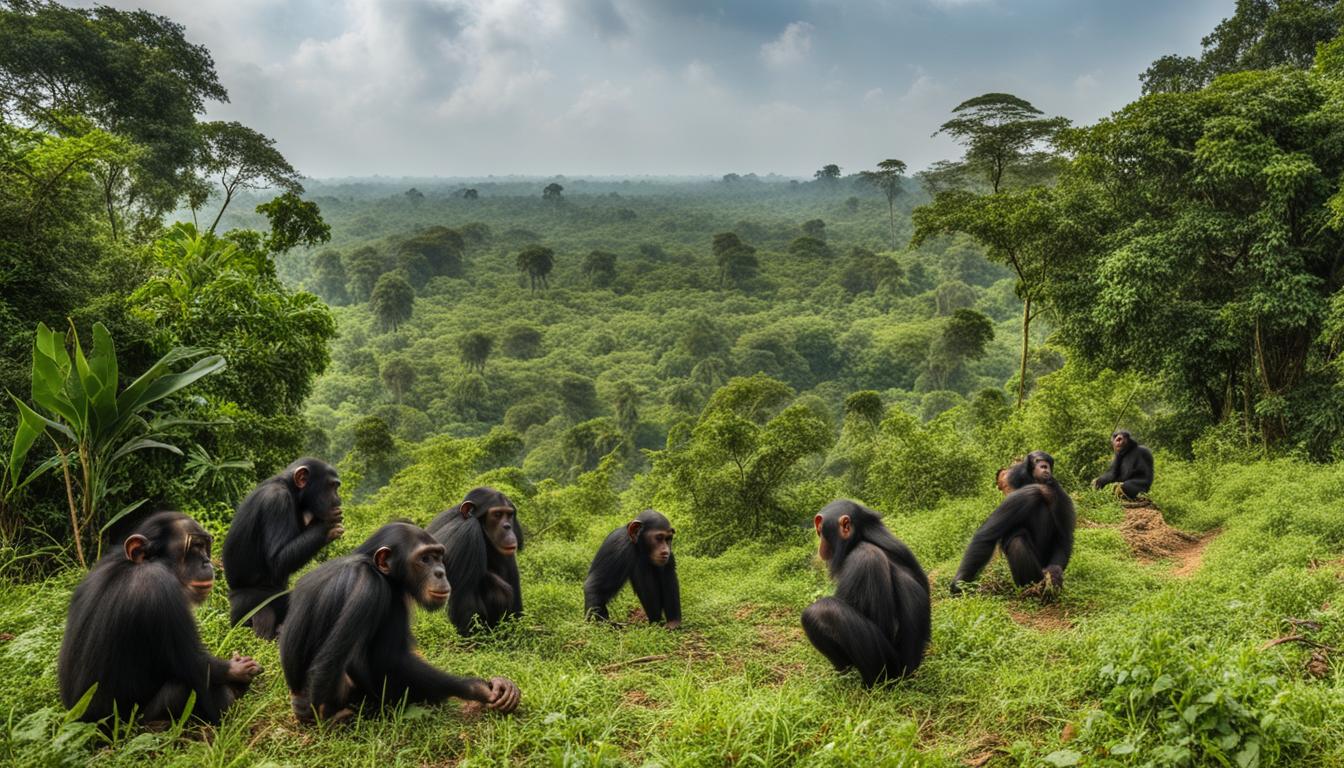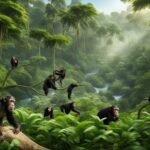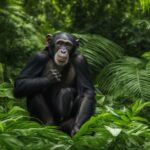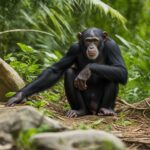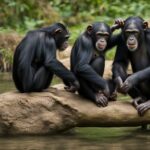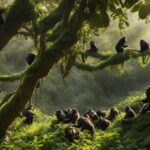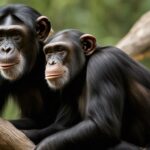Chimpanzees, our closest living relatives, face numerous threats to their survival, including hunting, habitat loss, and disease. However, there is hope on the horizon as successful chimpanzee conservation efforts have shown promising results. From collaborative programs to community-based initiatives, dedicated individuals and organizations are making a difference in protecting these incredible creatures.
In this article, we will explore some of the remarkable success stories in chimpanzee conservation and highlight the importance of these efforts. Whether you are interested in learning about inspiring achievements or looking for ways to contribute, this article will provide valuable insights into the world of successful chimpanzee conservation efforts.
Major threats to chimpanzees
Chimpanzees face three major threats that endanger their population and habitats: hunting, habitat loss, and disease. These threats are interconnected and pose significant challenges to the conservation of these remarkable creatures.
Hunting: Chimpanzees are hunted for their meat and body parts, driven by the demand for bushmeat and illegal wildlife trade. This hunting activity not only reduces chimpanzee populations but also disrupts social structures within their communities.
Habitat loss: Deforestation and land conversion for agriculture, logging, and infrastructure development have led to the destruction of chimpanzee habitats. The loss of their natural habitat limits their food sources and exposes them to increased human-wildlife conflict.
Disease: Chimpanzees are susceptible to diseases that can be transmitted from humans, such as respiratory infections and Ebola. As human encroachment into chimpanzee habitats increases, the risk of disease transmission rises, posing a significant threat to their survival.
To effectively protect chimpanzees, it is essential to address these major threats through comprehensive conservation strategies. By combatting hunting, promoting sustainable land-use practices, and implementing disease prevention measures, we can ensure the long-term survival of these incredible creatures.
Table: Major Threats to Chimpanzees
| Threat | Description |
|---|---|
| Hunting | Chimpanzees are hunted for bushmeat and illegal wildlife trade, impacting their populations and social structures. |
| Habitat Loss | Deforestation, land conversion, and human encroachment result in the destruction of chimpanzee habitats, limiting their food sources and increasing human-wildlife conflict. |
| Disease | Chimpanzees are vulnerable to diseases transmitted from humans, such as respiratory infections and Ebola, which are further exacerbated by human encroachment into their habitats. |
Collaboration with Government Agencies in the Recovery of Chimpanzees
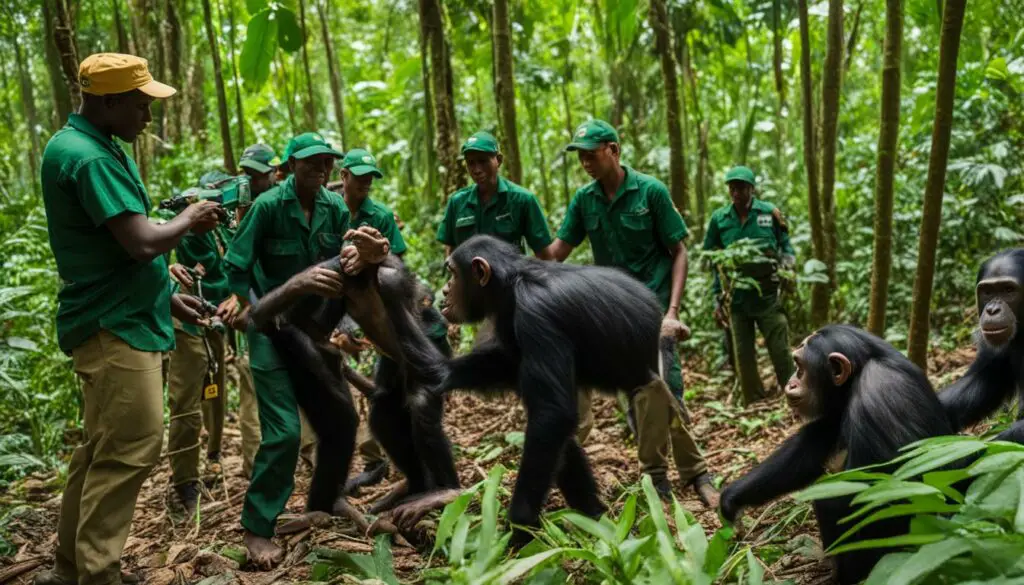
Collaboration between accredited facilities and government agencies has proven to be a crucial factor in the recovery of chimpanzees. By working together, these entities have been able to implement effective conservation measures and ensure the protection of these endangered creatures.
One notable example of such collaboration is the partnership between AZA-accredited facilities and government agencies in the United States. Through joint efforts, they successfully petitioned the U.S. Fish and Wildlife Service to grant full protections under the Endangered Species Act to all chimpanzees. This milestone decision marked an important step in ending private ownership and exploitation of chimpanzees in the country.
In addition to the U.S., collaboration between government agencies and accredited facilities can be seen in other parts of the world as well. By combining expertise and resources, these partnerships have led to the development and implementation of comprehensive conservation strategies. Together, they have been able to address key issues such as habitat protection, anti-poaching efforts, and disease prevention.
Collaborative Efforts in Action
A table showcasing some successful collaborative projects between government agencies and accredited facilities:
| Project | Location | Description |
|---|---|---|
| Tonkolili Chimpanzee Project | Sierra Leone | Community-based project that has led to increased protection for chimpanzees through a moratorium on killing |
| Mahale Mountains Chimpanzee Project | Tanzania | Collaboration between local authorities and researchers to protect the habitat of chimpanzees in Mahale Mountains National Park |
| Budongo Conservation Field Station | Uganda | Partnership between government agencies and researchers to conserve chimpanzees in Budongo Forest Reserve |
Continuing the Collaborative Efforts
The success achieved through collaboration between government agencies and accredited facilities in the recovery of chimpanzees demonstrates the importance of ongoing partnerships. By continuing to work together, these entities can further enhance conservation efforts, drive policy changes, and ensure the long-term survival of these incredible creatures.
Through joint initiatives, collaborative research, and shared resources, we can make a significant impact on chimpanzee conservation. By supporting and encouraging collaboration between government agencies and accredited facilities, we can protect and restore the habitats of these remarkable animals for generations to come.
Examples of Conservation Success
Chimpanzee conservation efforts have yielded impressive results in various projects around the world. These success stories serve as inspiration and showcase the positive impact that targeted initiatives can have on protecting these incredible species.
Ngogo Chimpanzee Project
The Ngogo Chimpanzee Project, located in Kibale National Park, Uganda, has achieved significant milestones in chimpanzee conservation. The project focuses on dismantling illegal snare traps to reduce injuries and mortality among chimpanzees. Through dedicated efforts, thousands of snares have been removed, creating a safer environment for the chimpanzees to thrive. The Ngogo Chimpanzee Project not only safeguards individual chimpanzees but also contributes to the preservation of the species as a whole.
Goualougo Triangle Ape Project
The Goualougo Triangle Ape Project, operating in the Republic of Congo, has made remarkable contributions to sustainable logging practices and conservation efforts. By working closely with local communities and partnering with logging companies, this project has successfully implemented measures to minimize the ecological impact of logging activities. The project’s innovative approach ensures the protection of chimpanzees and their habitats while supporting responsible economic development in the region.
Tonkolili Chimpanzee Project
The Tonkolili Chimpanzee Project, situated in Sierra Leone, has demonstrated the power of community-based conservation efforts. Through education and engagement, the project has established a moratorium on chimpanzee killing and incentivized local communities to protect these endangered creatures. This collaborative approach has fostered a sense of ownership and stewardship, leading to increased support for chimpanzee conservation within the region. The Tonkolili Chimpanzee Project stands as a testament to the positive impact that community involvement can have in preserving and restoring chimpanzee populations.
| Project | Location | Conservation Focus |
|---|---|---|
| Ngogo Chimpanzee Project | Kibale National Park, Uganda | Dismantling illegal snare traps |
| Goualougo Triangle Ape Project | Republic of Congo | Promoting sustainable logging practices |
| Tonkolili Chimpanzee Project | Sierra Leone | Community-based conservation and incentivization |
How to Help Chimpanzees
If you’re passionate about chimpanzee conservation, there are several ways you can contribute and make a positive impact. By making conscious choices in your daily life, you can help protect these incredible creatures and their habitats.
One important step is to support sustainable logging practices by purchasing Forest Stewardship Council (FSC) certified paper and wood products. This certification ensures that the wood used in these products comes from responsibly managed forests that prioritize the protection of wildlife habitats, including those of chimpanzees.
Another way to help is by donating to the AZA SAFE: Saving Animals From Extinction chimpanzee program. Your contribution will support collaborative conservation efforts aimed at improving the population status of all four chimpanzee subspecies. These funds will go toward projects that address the major threats facing chimpanzees and work toward their long-term survival.
Remember, every action counts, no matter how small. By choosing FSC-certified products and supporting the SAFE chimpanzee program, you are actively contributing to the protection of these remarkable creatures and ensuring a brighter future for chimpanzee conservation.
How You Can Help Chimpanzees:
- Purchase Forest Stewardship Council (FSC) certified paper and wood products
- Donate to the AZA SAFE: Saving Animals From Extinction chimpanzee program
Ambitious Offsets for Chimpanzee Conservation
Chimpanzee conservation offsets have been established to protect these endangered species, but they face significant challenges in achieving effective results. One notable case study is the Moyen Bafing National Park in Guinea, where a partnership between the private sector and conservation organizations has been implemented. However, there are shortcomings in this offset project that need to be addressed to ensure the long-term protection of chimpanzees and their habitats.
| Challenges in Chimpanzee Conservation Offsets | Recommendations for Improvement |
|---|---|
| 1. Limited Protection Timeline: The offset project at Moyen Bafing National Park has a limited timeline for protection, which raises concerns about the sustainability of conservation efforts. | 1. Extend the protection timeline to ensure long-term conservation impact. |
| 2. Potential Threats from Dam Construction: The construction of a dam within the park poses a potential threat to chimpanzee habitats, potentially undoing the conservation efforts. | 2. Collaborate with relevant stakeholders to find alternative solutions or mitigation measures that minimize the impact on chimpanzee populations. |
| 3. Insufficient Engagement with Local Communities: Effective offsets require the active involvement and support of local communities, which may be lacking in some offset projects. | 3. Strengthen community engagement initiatives by involving local communities in decision-making processes and providing them with incentives to participate in conservation efforts. |
Offset projects for chimpanzee conservation hold great potential in achieving “net gains” for these endangered species. However, it is crucial to address the challenges and shortcomings to ensure the effectiveness and long-term success of such initiatives. By making the necessary improvements and implementing robust conservation strategies, ambitious offsets can play a significant role in safeguarding the future of chimpanzees and their habitats.
Chimpanzee conservation offsets, like the one at Moyen Bafing National Park, require continuous monitoring and adaptive management to track progress and make adjustments when necessary. By learning from past experiences, we can work towards more effective offsets that truly contribute to the preservation of chimpanzees and their ecosystems.
Conclusion
Chimpanzee conservation success stories highlight the incredible achievements that have been made in protecting these remarkable creatures. Through collaboration and targeted initiatives, positive examples of chimpanzee conservation have emerged, offering hope for the future.
Community-based projects, such as the Tonkolili Chimpanzee Project in Sierra Leone, have successfully implemented measures to halt chimpanzee killing and increase protection for the species. This inspiring achievement demonstrates the power of local efforts in safeguarding chimpanzees and their habitats.
Partnerships between accredited facilities and government agencies have also played a significant role in chimpanzee conservation. Through collaboration, these organizations have been able to secure full protections for chimpanzees under the Endangered Species Act, marking a critical milestone in their recovery.
By addressing the major threats chimpanzees face, such as hunting, habitat loss, and disease, and by supporting conservation programs, individuals can contribute to the remarkable results already achieved. Every conscious choice, whether it’s using Forest Stewardship Council (FSC) certified products or donating to the SAFE chimpanzee program, can make a difference in protecting these incredible creatures for generations to come.
What are some successful cases of chimpanzee conservation efforts?
Some successful chimpanzee conservation cases include the work of the Jane Goodall Institute, which focuses on protecting chimpanzee habitats in Tanzania. Another case is the efforts of the World Wildlife Fund in the Congo Basin, where they have implemented anti-poaching measures to safeguard chimpanzee populations.
FAQ
Are there successful cases of chimpanzee conservation?
Yes, there have been successful cases of chimpanzee conservation. Examples include the AZA SAFE: Saving Animals From Extinction chimpanzee program and the Tonkolili Chimpanzee Project in Sierra Leone.
What are the major threats to chimpanzees?
Chimpanzees face three significant threats: hunting, habitat loss, and disease.
How is collaboration with government agencies aiding in chimpanzee recovery?
Collaboration with government agencies has played a crucial role in protecting chimpanzees, particularly through the granting of full protections under the Endangered Species Act and ending private ownership and exploitation of chimpanzees in the United States.
Can you provide examples of successful conservation initiatives?
Yes, examples of successful conservation initiatives include the Ngogo Chimpanzee Project, the Goualougo Triangle Ape Project, and the Tonkolili Chimpanzee Project.
How can individuals help chimpanzees?
Individuals can help chimpanzees by using Forest Stewardship Council (FSC) certified products and donating to the SAFE chimpanzee program.
What are the challenges in chimpanzee conservation offsets?
Challenges in chimpanzee conservation offsets include limited protection timelines and potential threats from other developments within protected areas, as seen in the Moyen Bafing National Park case.
What is the conclusion on chimpanzee conservation success stories?
Chimpanzee conservation success stories demonstrate the positive impact of collaborative efforts and targeted initiatives, inspiring achievements in protecting these incredible creatures.

